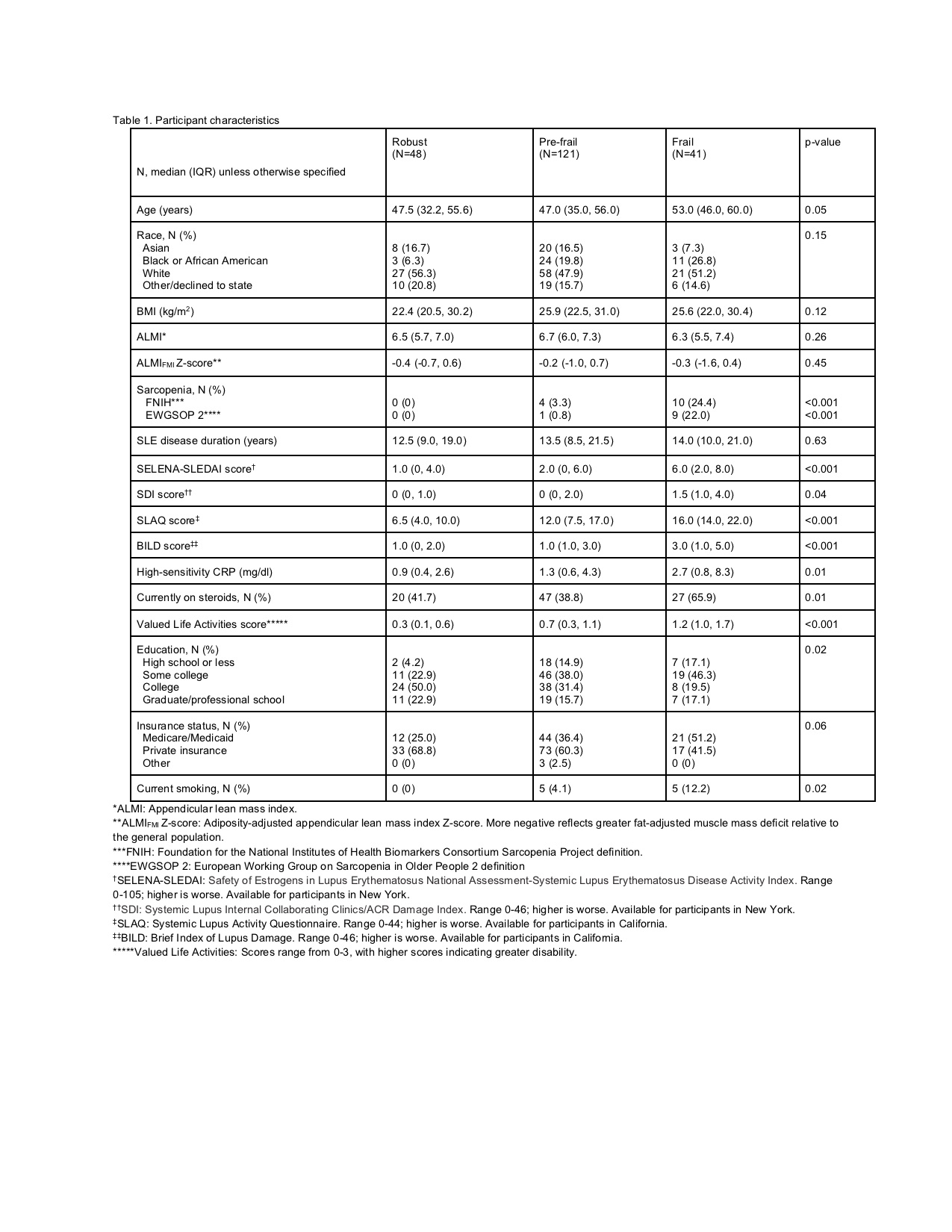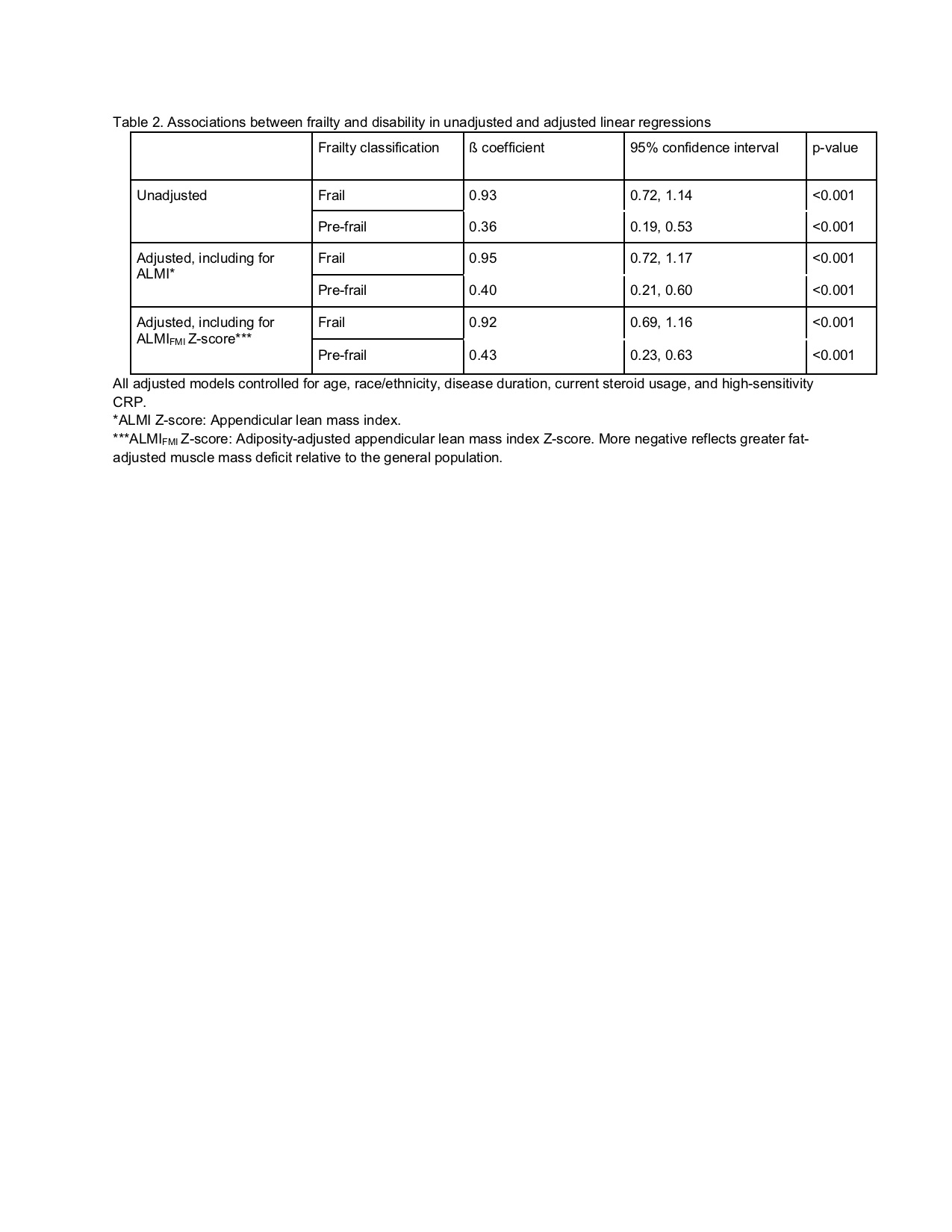Session Information
Date: Sunday, November 8, 2020
Title: SLE – Diagnosis, Manifestations, & Outcomes Poster II: Comorbidities
Session Type: Poster Session C
Session Time: 9:00AM-11:00AM
Background/Purpose: Frailty has been associated with disability and mortality in SLE. Whether this association is confounded by sarcopenia, a degenerative loss of muscle mass and quality typically associated with aging, has not been explored. This aim of this study is to evaluate the cross-sectional association of frailty with self-reported disability, adjusting for lean body mass.
Methods: Adult women with validated SLE and mild/moderate disease were recruited from 2 centers. Frailty and pre-frailty were measured according to Fried frailty criteria (unintended weight loss, weakness, slow gait, poor endurance, inactivity) and disability according to Valued Life Activities. Dual energy x-ray absorptiometry was used to compute sarcopenia based on 2 definitions (Foundation for the National Institutes of Health Biomarkers Consortium Sarcopenia Project [1] and European Working Group on Sarcopenia in Older People 2 [2]) incorporating measures of muscle strength and quantity. Associations between frailty and disability were determined using univariate and multivariate linear regression models adjusted for age, race/ethnicity, SLE duration, current steroid use, high-sensitivity CRP (hsCRP), and 2 measures of lean body mass, appendicular lean mass index (ALMI) and adiposity-adjusted ALMI Z-score, reflecting the number of standard deviations from average for a given level of adiposity using National Health and Nutrition Examination Survey reference ranges.
Results: In the combined cohort of 210 women with SLE, 20% of participants were frail and 58% were pre-frail (Table 1). Frail women were significantly older (p=0.05), with lesser educational attainment (p=0.02), greater disease activity (p< 0.001), more damage (p=0.04 for SLICC/ACR Damage Index; p< 0.001 for Brief Index of Lupus Damage), higher hsCRP (p=0.01), and more frequent steroid use (p=0.01) and cigarette smoking (p=0.02). Sarcopenia was more prevalent among frail women with SLE as compared to pre-frail and non-frail women according to both definitions (p< 0.001). There was a significant dose-dependent association between frailty and pre-frailty and disability (p< 0.001), which was not attenuated after adjustment for multiple confounders and either measure of lean body mass (Table 2).
Conclusion:
Frailty was significantly associated with disability. Sarcopenia was more common among frail than pre-frail and non-frail women with SLE. The association of frailty with disability was not attenuated by multiple covariates, including lean body mass. These data suggest that frailty is a distinct phenotype not fully described by direct measures of low muscle mass. Further study is needed to determine the relative contributions of frailty and sarcopenia to other adverse health outcomes in SLE.
References:
1. Studenski et al. J Gerontol A Biol Sci Med Sci 2014;69:547-8.
2. Cruz-Jentoft et al. Age Ageing 2019;48:16-31.
To cite this abstract in AMA style:
Lieber S, Katz P, Baker J, Jannat-Khah D, Sheira D, Mandl L. Association of Frailty with Disability Is Not Attenuated by Lean Body Mass in Women with SLE [abstract]. Arthritis Rheumatol. 2020; 72 (suppl 10). https://acrabstracts.org/abstract/association-of-frailty-with-disability-is-not-attenuated-by-lean-body-mass-in-women-with-sle/. Accessed .« Back to ACR Convergence 2020
ACR Meeting Abstracts - https://acrabstracts.org/abstract/association-of-frailty-with-disability-is-not-attenuated-by-lean-body-mass-in-women-with-sle/


